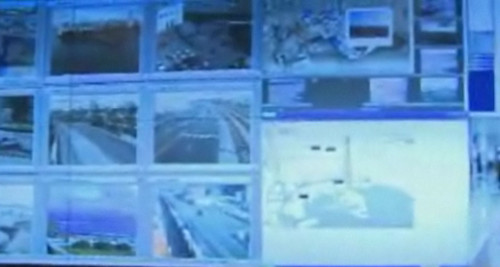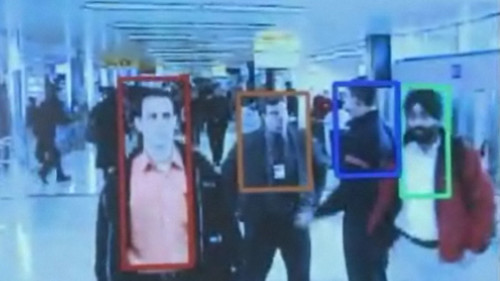Inside Long Beach's New Panoptic Nerve Center
The BBC got a sneak peak inside a new surveillance command center at the Long Beach Port in California, one of the busiest ports (and for awhile, most vulnerable) in the world along side LA’s, which combined are responsible for 45 percent of the U.S.’s cargo container traffic.
"The center," this article tells us, "sits on a narrow strip of land within the harbor, controls an assortment of cameras, motion sensors, and security teams that monitor the port's 3,200 acres. and acts as a fusion center for hundreds of local, state, and federal agents."
As you’d expect, inside this hive of spectral vigilance is essentially a massive grid-display of strategic camera views laid out across a big screen streaming angular scenes of filmic bore from corners all around the port, near highways, access roads, over buildings, and inside the port’s facilities where new facial recognition software is being tested. "Some of the port's 115 cameras are so powerful, operators can read the badge number of someone standing two miles away," said Cosmo Perrone, the port's director of security.
It’s a kind of enlarged retinal scan of the entire Port district at which the center sits this $21m cubicle space of endless watching.

One thing strikes me – for a panoptic nerve center it just seems so innocuously standard in terms of its space of operation. Sure, it’s incredibly high-tech, but for all intents and purposes it looks like any old room hidden somewhere in a basement filled with PCs and oversized monitors, a few Aeron chairs, some air-con vents and overactive coffee makers.
It cracks me up how incredibly uninteresting this place looks. I guess I’m too easily seduced by more curious fantasies of what these types of security spaces are supposed to look like (perhaps it should look like something at least vaguely futuristic, that might give even the remotest bit of reality to Hollywood’s sci-fi depictions of the Pentagon’s hyper-informatic spy rooms), but no –
See for yourself – this ‘surveillance command center’ is just so disappointingly mundane and generic it could be any old innocuous business hoping to survive on a month-to-month lease somewhere cheap; a corporate squat: a private executive screening room; a pirate media station secretly running from inside a forgotten storage facility locked up long ago within an Oracle data center.

When I think of 'national security command centers' I can’t help but get a little giddy if just to glimpse for a moment something normally considered un-glimpsable, something with incomprehensible interface, the sight of a new disturbing geospatial surveillance paradigm. Imagine peeking into a chamber of the Emperor’s Death Star. Anytime I come across a video like this I must confess there is a creepy thrill at the prospect of getting to look inside something frighteningly Big Brother in the most architectural sense. What exists on the other side of that great panoptic tinted glass?
In reality, behind the curtain is just the opposite – an utterly anti-climatic phenomenology of American office space.
I mean, come on, that’s it? That’s the space that oversees one of the world’s most active port security systems? Granted, the video only provides a clip, but – wow.

Even in terms of work environments, would you ever want to work there, behind those little desks, under that predictable overhead lighting? No offense to the designers, but – man, from that view, the space doesn’t do a Panoptic Nerve Center any mythological justice, that’s for sure. Oh well. It’s no secret I’ve seen all the Bond movies way too many times by now.
Near the end of the video we get to see the massive room-filling hard drive padded on earthquake dampeners that keeps the whole thing safe and running – one of several brain boxes powering LA’s scopic regime where each day it logs reams and reams of probably the most boring action thriller footage ever recorded in LA.
But I guess there’s just something perfect in that – behind the pantopic curtains of global surveillance is just this monstrous computing box hovering in the palm of some boring-ass Los Angeles office space. Despite all the secrecy around national security command centers, in the end – it’s just a PC and monitor running intelligent software, and in some ways producing the perfect counter-films to Hollywood’s billion dollar blockbusters.
Here, a single box controls hundreds of remote cameras simultaneously whose objective is everything classic film production is not: to make a film focusing on all the extras, to waste as much film as possible, record the set from every angle, and capture the mis en scene of an action film so as to render no action at all!
It’s the film space the other side of Hollywood – call them, total situational sleeper films – the art of the surveillance anti-thriller.
Related: LA's Surveillance Timeblades; The Killer Drone's Afghani Hive; War Room; The Panoptic Arcade; "Sweet Tea"; Architectural Clairvoyance and the Spaces of Terrorist Prevention.
(Thanks G for the link!)
"The center," this article tells us, "sits on a narrow strip of land within the harbor, controls an assortment of cameras, motion sensors, and security teams that monitor the port's 3,200 acres. and acts as a fusion center for hundreds of local, state, and federal agents."
As you’d expect, inside this hive of spectral vigilance is essentially a massive grid-display of strategic camera views laid out across a big screen streaming angular scenes of filmic bore from corners all around the port, near highways, access roads, over buildings, and inside the port’s facilities where new facial recognition software is being tested. "Some of the port's 115 cameras are so powerful, operators can read the badge number of someone standing two miles away," said Cosmo Perrone, the port's director of security.
It’s a kind of enlarged retinal scan of the entire Port district at which the center sits this $21m cubicle space of endless watching.

One thing strikes me – for a panoptic nerve center it just seems so innocuously standard in terms of its space of operation. Sure, it’s incredibly high-tech, but for all intents and purposes it looks like any old room hidden somewhere in a basement filled with PCs and oversized monitors, a few Aeron chairs, some air-con vents and overactive coffee makers.
It cracks me up how incredibly uninteresting this place looks. I guess I’m too easily seduced by more curious fantasies of what these types of security spaces are supposed to look like (perhaps it should look like something at least vaguely futuristic, that might give even the remotest bit of reality to Hollywood’s sci-fi depictions of the Pentagon’s hyper-informatic spy rooms), but no –
See for yourself – this ‘surveillance command center’ is just so disappointingly mundane and generic it could be any old innocuous business hoping to survive on a month-to-month lease somewhere cheap; a corporate squat: a private executive screening room; a pirate media station secretly running from inside a forgotten storage facility locked up long ago within an Oracle data center.

When I think of 'national security command centers' I can’t help but get a little giddy if just to glimpse for a moment something normally considered un-glimpsable, something with incomprehensible interface, the sight of a new disturbing geospatial surveillance paradigm. Imagine peeking into a chamber of the Emperor’s Death Star. Anytime I come across a video like this I must confess there is a creepy thrill at the prospect of getting to look inside something frighteningly Big Brother in the most architectural sense. What exists on the other side of that great panoptic tinted glass?
In reality, behind the curtain is just the opposite – an utterly anti-climatic phenomenology of American office space.
I mean, come on, that’s it? That’s the space that oversees one of the world’s most active port security systems? Granted, the video only provides a clip, but – wow.

Even in terms of work environments, would you ever want to work there, behind those little desks, under that predictable overhead lighting? No offense to the designers, but – man, from that view, the space doesn’t do a Panoptic Nerve Center any mythological justice, that’s for sure. Oh well. It’s no secret I’ve seen all the Bond movies way too many times by now.
Near the end of the video we get to see the massive room-filling hard drive padded on earthquake dampeners that keeps the whole thing safe and running – one of several brain boxes powering LA’s scopic regime where each day it logs reams and reams of probably the most boring action thriller footage ever recorded in LA.
But I guess there’s just something perfect in that – behind the pantopic curtains of global surveillance is just this monstrous computing box hovering in the palm of some boring-ass Los Angeles office space. Despite all the secrecy around national security command centers, in the end – it’s just a PC and monitor running intelligent software, and in some ways producing the perfect counter-films to Hollywood’s billion dollar blockbusters.
Here, a single box controls hundreds of remote cameras simultaneously whose objective is everything classic film production is not: to make a film focusing on all the extras, to waste as much film as possible, record the set from every angle, and capture the mis en scene of an action film so as to render no action at all!
It’s the film space the other side of Hollywood – call them, total situational sleeper films – the art of the surveillance anti-thriller.
Related: LA's Surveillance Timeblades; The Killer Drone's Afghani Hive; War Room; The Panoptic Arcade; "Sweet Tea"; Architectural Clairvoyance and the Spaces of Terrorist Prevention.
(Thanks G for the link!)







2 Comments:
...and security teams that monitor the port's 3,200 sq. ft.
That seems rather small for a Port !
The original article Port security: Command & Control
says
And he's especially proud of a new $21-million security compound on Pier F that serves as a nerve center for the hundreds of cameras, motion sensors and human personnel surveilling nearly every square foot of the port's 3,200 acres
Ha! That's funny. and Strange. Same article, different sources, obviosuly a typo, I should have caught that!
Thanks. I updated my post, with both corect info and source.
b
Post a Comment
<< Home